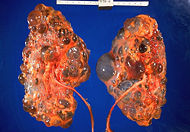Polycystic kidney disease
| Polycystic Kidney Disease Classification and external resources |
|
 |
|
|---|---|
| Polycystic kidneys | |
| ICD-10 | Q61. |
| ICD-9 | 753.1 |
| OMIM | 173900 |
| DiseasesDB | 10262 10280 |
| MedlinePlus | 000502 |
| eMedicine | med/1862 ped/1846 radio/68 radio/69 |
| MeSH | D007690 |
Polycystic kidney disease (PKD, also known as polycystic kidney syndrome) is a progressive, ciliopathic, genetic disorder of the kidneys. It occurs in humans and other animals. PKD is characterized by the presence of multiple cysts (hence, "polycystic") in both kidneys. The disease can also damage the liver, pancreas, and rarely, the heart and brain. The two major forms of polycystic kidney disease are distinguished by their patterns of inheritance.
Autosomal dominant polycystic kidney disease (ADPKD) is generally a late-onset disorder characterized by progressive cyst development and bilaterally enlarged kidneys with multiple cysts. Kidney manifestations in this disorder include renal function abnormalities, hypertension, renal pain, and renal insufficiency. Approximately 50% of patients with ADPKD have end-stage renal disease (ESRD) by the age of 60. ADPKD is a systemic disease with cysts in other organs such as the liver (which may lead to cirrhosis), seminal vesicles, pancreas, and arachnoid mater and non-cystic abnormalities such as intracranial aneurysms and dolichoectasias, dilation of the aortic root and dissection of the thoracic aorta, mitral valve prolapse, and abdominal wall hernias.
Initial simian and human symptoms are hypertension, fatigue, and mild to severe back or flank pain and urinary tract infections. The disease often leads to chronic renal failure and may result in total loss of kidney function, known as end stage renal disease (ESRD), which requires some form of renal replacement therapy (e.g. dialysis).
Autosomal recessive polycystic kidney disease (ARPKD) is much rarer than ADPKD and is often fatal in utero or during the first month of life. The signs and symptoms of the condition are usually apparent at birth or in early infancy.
Genetics
The disease exists both in an autosomal recessive and an autosomal dominant form.
A small number of families with polycystic kidney disease do not have apparent mutations in any of the three known genes. An unidentified gene or genes may also be responsible for this disease. In this case, the disease is designated "PKD3".
In cats
Polycystic Kidney Disease (PKD) is also prevalent in Persian, Himalayan, and Exotic Cats.
There are 3 possible genotypes for PKD:
- 1) N/N (2 copies of the normal allele)
- 2) N/P Heterozygote (1 normal copy and 1 copy of the PKD mutation)
- 3) P/P (2 copies of the PKD mutation)
PKD DNA testing is available to identify these genotypes to help cat breeders make more informed decisions about mating patterns.
References
|
||||||||||||||||||||||||||
|
|||||||||||||||||||||||